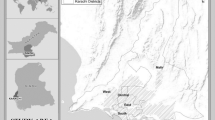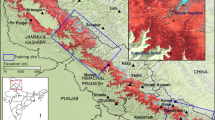Abstract
Invasive species have been the focus of environmentalists due to their undesired impact on the ecosystem. Spread of Lantana (Lantana camara L.), an invasive plant species, has been found in diverse geophysical environments causing a threat to the native flora. Various eradication programmes have been attempted such as burning, chemical sprays, bio-control agents and physical plugging mechanism for removing such invasive species in India. The efforts and success of these programmes need to be augmented with a correct, quick and cost effective technique of mapping in order to locate them, understand their spatial extent and hence make the process comprehensive. Also Lantana’s appearance as dense vegetation patches in remote sensing data causes problems for estimating forest canopy density. Remote sensing provides a possible solution in qualitatively and quantitatively evaluating terrestrial surface vegetation cover using spectral measure-ments. This research paper addresses issues and techniques adopted to detect and extract Lantana, and can be used for various applications in forestry as well as in eradication programmes. This study attempted to understand the appropriate band combination using Landsat data and generating vegetation indices in order to extract Lantana patches in an accurate manner. Twenty nine different vegetation indices were analyzed for their effectiveness in differentiating Lantana from other classes. The study showed that SAVI (Soil Adjusted Vegetation Index) is most favorable in discriminating Lantana followed by Perpendicular Vegetation Index-3 in the optimum bio-window (February to April).
Similar content being viewed by others
Abbreviations
- VI 1:
-
Simple Ratio
- VI 2:
-
NDVI (Normalised Difference Vegetation Index)
- VI 3:
-
TVI (Transformed Vegetation Index)
- VI 4:
-
CTVI (Corrected Transformed Vegetation Index)
- VI 5:
-
TTVI (Thiam’s Transformed Vegetation Index)
- VI 6:
-
RVI (Ratio Vegetation Index)
- VI 7:
-
NRVI (Normalised Ratio Vegetation Index)
- VI 8:
-
PVI (Perpendicular Vegetation Index)
- VI 9:
-
PVI (Perpendicular Vegetation Index)-1
- VI 10:
-
PVI (Perpendicular Vegetation Index)-2
- VI 11:
-
PVI (Perpendicular Vegetation Index)-3
- VI 12:
-
DVI (Difference Vegetation Index)
- VI 13:
-
AVI (Ashburn Vegetation Index)
- VI 14:
-
SAVI_L1 (Soil Adjusted Vegetation Index)
- VI 15:
-
SAVI_L0.5 (Soil Adjusted Vegetation Index)
- VI 16:
-
SAVI_L0.25 (Soil Adjusted Vegetation Index)
- VI 17:
-
TSAVI (Transformed SAVI)
- VI 18:
-
TSAVI (Transformed SAVI)-1
- VI 19:
-
TSAVI (Transformed SAVI)-2
- VI 20:
-
WDVI (Weighted Difference Vegetation Index)
- VI 21:
-
MSAVI (Modified SAVI)
- VI 22:
-
MSAVI (Modified SAVI)-1
- VI 23:
-
MSAVI (Modified SAVI)-2
- VI 24:
-
GEMI (Global Environment Monitoring Index)
- VI 25:
-
EVI (Enhanced Vegetation Index)
- VI 26:
-
AVI (Advanced Vegetation Index)
- VI 27:
-
BI (Bare Soil Index)
- VI 28:
-
SI (Shadow Index)
- VI 29:
-
Thermal Index (TI)
- Landsat TM:
-
Landsat Thematic Mapper
- Landsat ETM:
-
Landsat Enhanced Thematic Mapper
- MSS:
-
Multispectral Scanner
- LAI:
-
Leaf Area Index
References
ARMC (2000) Weeds of national significance, Lantana Camara, National Weeds Strategy Executive Committee, Agriculture and Resource Management Council of Australia and New Zealand, Australian and New Zealand Environment and Conservation Council and Forestry Ministers Launceston, available online at:http://www.nrw.qld.gov.au/pests/weeds/wons/pdf/Lantana_nsplan.pdf (Accessed, 04 August 2005)
Asner GP and Vitousek PM (2005) Remote analysis of biological invasion and biogeochemical change. Proceedings of The National Academy of Sciences of The United States of America 102: 4383–4386
Bannari A, Morin D, Bonn F and Huete AR (1995) A Review of Vegetation Indices. Remote Sensing Reviews 13:95–120
Chandrasekhar MB, Saran S, Raju PLN and Roy PS (2005) Forest Canopy Density Stratification: How relevant is Biophysical Spectral Response Modelling Approach? Geocarto International 20(1):15–21
Clinton NJ and Stuart LP (2003) How big is the global weed patch? Annals of Missouri Botanical Garden 90:172–178
Cohen WB and Goward SN (2004) Landsat’s role in ecological applications of remote sensing. BioScience 54: 535–545
David F (2001) Vegetation Index Definitions. CRESS Project, UMCP Geography
Drake JA, Mooney HA, Castri FD, Groves RH, Kruger, FJ, Aejmamek M and Williamson M (1989) Biological invasions: a global perspective. John Wiley and Sons: Chichester
FSI (Report) (2005) Forest Survey of India, Dehra Dun
Gilabert MA, Gonzales Piqueras J, Garcia Haro FJ and Melia J (2002) A generalized soil adjusted vegetation Index. Remote Sensing of Environment 82:303–310
Govaerts Y, Verstraete MM, Pinty B and Gobron N (1999) Designing optimal spectral indices: A feasibility and proof of concept study. International J of Remote Sensing 20(9):1853–1873
Huete AR, Jackson RD and Post DF (1985) Spectral response of a plant canopy with different soil backgrounds. Remote Sensing of Environment 17:37–53
Huete AR (1988) A Soil Adjusted Vegetation Index (SAVI). Remote Sensing of Environment 25:295–309
Holm LG, Plucknett DL, Pancho JV and Herberger JP (1977) The World’s Worst Weeds: Distribution and Biology, Univ. Press of Hawaii: Honolulu
Jenson JR (1996) Introductory Digital Image Processing, New Jersey: Prentice Hall
Joshi C, Leeuw JD and Duren ICV (2004) Remote sensing and GIS applications for mapping and spatial modelling of invasive species. In: ISPRS 2004: Proceedings of the XXth ISPRS congress: Geo imagery bridging continents, held at Istanbul, Turkey. Comm. VII, 669–677
Leprieur C, Verstraete MM and Pinty B (1994) Evaluation of the performance of various vegetation indices to retrieve vegetation cover from AVHRR data. Remote Sensing Reviews 10:265–284
Liu HQ and Huete A (1995) A feedback based modification of the NDVI to minimize canopy background and atmospheric noise. IEEE Transactions on Geosciences and Remote Sensing 33(2):457–465
Lillesand TM and Kiefer RW (2000) Remote sensing and image interpretation, fourth edition, John Wiley and Sons, Inc, New York
Lowe S, Browne M and Boudjelas S (2001) 100 of the world’s worst invasive alien species. Invasive species Specialist Group, IUCN/SSC GISP
Murali KS and Setty RS (2001) Effect of weeds Lantana Camara and Chromelina Odorata growth on the species diversity, regeneration and stem density of tree and shrub layer in BRT sanctuary. Current Science 80(5):675–678
Peddle DR, Hall FG and Ledrew EF (1999) Spectral mixture analysis and geometricoptical reflectance modelling of boreal forest biophysical structure. Remote Sensing of Environment 67:288–297
Pinty B and Verstraete MM (1991) GEMI: A Non-Linear Index to Monitor Global Vegetation from Satellites. Plant Ecology 101:15–20
Ramachandra TV and Uttam Kumar (2004) Watershed management using GRDSS. GIS Development 8(8):20–26
Rawat GS and Bhainsora NS (1999) Woody vegetation of Shiwaliks and outer Himalaya in north western India. Tropical Ecology 40(1):119–128
Rikimaru A (1999) The concept of FCD Mapping Model and Semi Expert System. FCD Mapper User’s Guide, International Tropical Timber Organization and Japan Overseas Forestry Consultants Association, 90
Roy DP, Kennedy P and Folving S (1997) Combination of the normalized Difference Vegetation Index and surface temperature for regional scale European forest cover mapping using AVHRR data. International J of Remote Sensing 18(5):1189–1195
Roy PS, Miyatake S and Rikimaru A (1997) Biophysical Spectral Response Modelling Approach for Forest Density Stratification. FCD Mapper User’s Guide
Sharma GP, Singh JS and Raghubansi AS (2005) Plant invasions: Emerging trends and future implications. Current Science 88(5):726–734
Sivaramakrishan VR (1976) Occurrence of Lantana lace bug, Teleonemia scrupulosa Stal. (Hemiptera: Tinigidae) in South India. Indian Forester 102(9):620–622
Terrill RW (1994) A FAQ on Vegetation in Remote Sensing. California Institute of Technology, Available online at: http://kepler.gps.caltech.edu/%20pub/Terrill/rsvegfaq.txt (Accessed 04 August 2005)
Thakur ML, Ahmed M and Thakur RK (1992) Lantana weed (Lantana camara var. aculeata Linn) and its possible management through natural insect pests in India. Indian Forester 118, 7
Ustin SL, DiPietro D, Olmstead K, Underwood E and Scheer GJ (2002) Hyperspectral Remote Sensing for Invasive Species Detection and Mapping, IEEE, 1658–1660
Verstraete MM and Pinty B (1996) Designing optimal spectral indices for remote sensing applications. IEEE Transactions on Geoscience and Remote Sensing 34:1254–1265
Wilcove DS and Chen LY (1998) Management costs for endangered species. Conservation Biology 12:1405–1407
Author information
Authors and Affiliations
Corresponding author
About this article
Cite this article
Kandwal, R., Jeganathan, C., Tolpekin, V. et al. Discriminating the invasive species, ‘Lantana’ using vegetation indices. J Indian Soc Remote Sens 37, 275–290 (2009). https://doi.org/10.1007/s12524-009-0027-5
Received:
Accepted:
Published:
Issue Date:
DOI: https://doi.org/10.1007/s12524-009-0027-5




